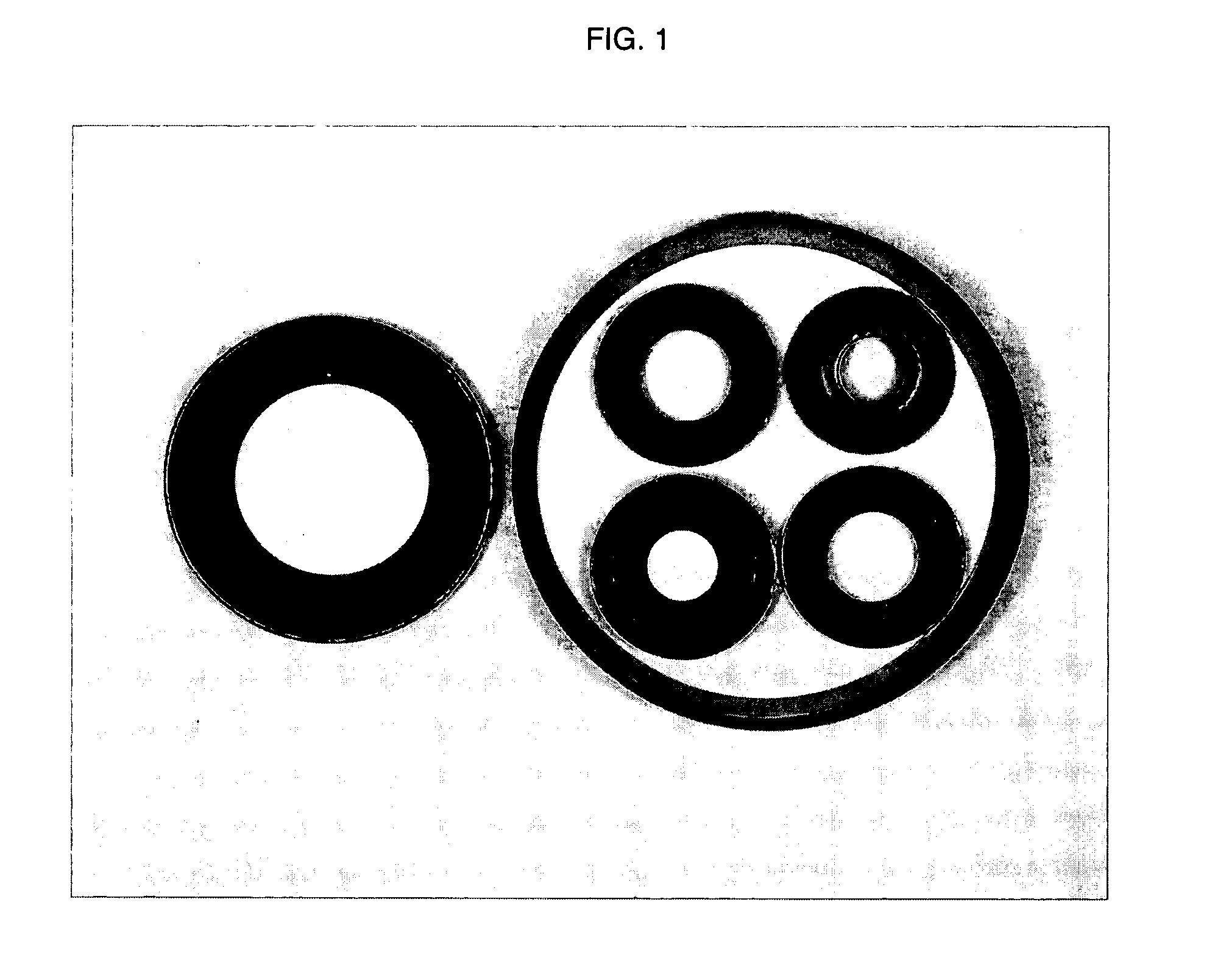Low-formaldehyde thermoplastic seal adhesive
a thermoplastic seal and low formaldehyde technology, applied in the field of adhesives, can solve the problem and achieve the effect of high degree of rubber cohesive failur
- Summary
- Abstract
- Description
- Claims
- Application Information
AI Technical Summary
Benefits of technology
Problems solved by technology
Method used
Image
Examples
example 1
[0057] The following materials are combined.
Wet wt.Dry wt.Example 1(gms)(gms.)Phenolic Novolak* (47.7% solids)11.665.56 gChlor. natural rubber latex (50% solids)11.665.83 gWt. (gms)masterbatchlignosulfonate0.22Zinc Oxide4.03Silica2.74Carbon black1.61DI Water68.8
*phenol / resorcinol / formaldehyde resin (F / P < 1)
[0058] The dry ingredients were combined with Dl water in a masterbatch and run through a sandmill until a Hegman grind of less than 1.5 mils was obtained. The phenolic resin (pyrogallol-resorcinol-formaldehyde novolak resin) was stirred into the masterbatch with a paddle mixer and allowed to mix for 15 minutes to neutralize any free acid. After 15 minutes chlorinated natural rubber latex was added to the mixture and stirred with a paddle mixer until homogeneous (30 minutes).
[0059] The adhesive composition prepared from Example 1 was coated onto 0.125 inch (3.1 mm) phosphatized steel coupons, and dried to a dry film thickness (DFT) of 0.0003 in. (0.0076 mm) and the adhesive-c...
example 2
[0072] The following formula was combined into adhesives for Example 2 and coated to the same DFT on the same zinc phosphatized coupons used in Example 1. Examples in this series compared adhesives containing chlorinated natural rubber latex vs. chlorosulfonated polyethylene (CSM), with and without tri-methylol nitromethane (TMNM) crosslinker. The tables below show the effect of latex type and crosslinker on adhesion performance under pre-bake conditions.
Wet wt.Dry wt.Example 1(gms)(gms.)Phenolic Novolak* (47.7% solids)11.665.56 glatex - as indicated11.665.83 gWt. (gms)masterbatchlignosulfonate0.22Zinc Oxide4.03Silica2.74Carbon black1.61DI Water68.8
*phenol-resorcinol-formaldehyde resin (F / P < 1)
[0073] Examples
2Achlorosulfonated polyethylene + 0.5% TMNMcomparative2Bchlorinated natural rubber latex + 0.5% TMNMcomparative2Cchlorosulfonated polyethylene + 1% TMNMcomparative2Dchlorinated natural rubber latex (C-NR) + 1% TMNMcomparative2Echlorosulfonated polyethylene + 2% TMNMcompara...
example 3
[0076] The following adhesives were formulated using different chlorinated polymer latexes, chlorosulfonated polyethylene (CSM), chlorinated natural rubber lates, and a homopolymer of 2,3-dichlorod butadiene latex to compare the effect of substituting for chlorinated natural rubber. The comparison includes the effect of substituting a novolak resin with resole resins. TSC refers to total solids content in weight %.
Example 3Wet wt. (gms)Phenolic Novolak* (type indicated below)12.07Latex** (type indicated below)12.07Wt. (gms)Masterbatchlignosulfonate0.224Zinc Oxide4.07Silica2.78Carbon black0.678TiO21.36DI Water67.168
[0077]
Example*Phenolic TSC (wt. %)** latex (TSC) (wt. %)3-A(invention)novolak (Ex. 1) (47.7)C-NR (50%)3-Bnovolak B3 20%C-NR (50%)3-Cresole resin† 51%C-NR (50%)3-Dresole resin‡ 47%C-NR (50%)3-Enovolak (Ex. 1) (47.7)43%-chlorine CSM (50%)3-Fnovolak (Ex. 1) (47.7)24% Chlorine CSM (50%)3-Gnovolak (Ex. 1) (47.7)2,3-DCD latex (35.73%)
PUM
| Property | Measurement | Unit |
|---|---|---|
| surface area | aaaaa | aaaaa |
| particle size | aaaaa | aaaaa |
| wt. % | aaaaa | aaaaa |
Abstract
Description
Claims
Application Information
 Login to View More
Login to View More - R&D
- Intellectual Property
- Life Sciences
- Materials
- Tech Scout
- Unparalleled Data Quality
- Higher Quality Content
- 60% Fewer Hallucinations
Browse by: Latest US Patents, China's latest patents, Technical Efficacy Thesaurus, Application Domain, Technology Topic, Popular Technical Reports.
© 2025 PatSnap. All rights reserved.Legal|Privacy policy|Modern Slavery Act Transparency Statement|Sitemap|About US| Contact US: help@patsnap.com

